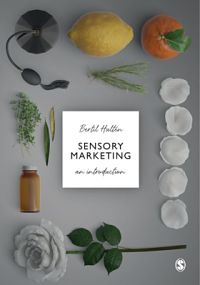The Secrets of the Human Mind (and Marketing)
My idea with this book title Sensory Marketing – An Introduction – is to present state of the art in sensory marketing. The significance of the five human senses is emphasized in relation to how multisensory cues and stimuli impact individual’s cognitions, emotions, and purchase behavior as customers. For many years marketing research and literature gave no attention to how humans perceived brands, products, and services through the five human senses in various contexts.

The book is filling a gap in the marketing literature in analyzing and discussing how companies could apply multisensory cues for vision, sound, smell, touch, and taste in business practice. The challenge for me this time was to write a book based on findings and conclusions from contemporary research and presenting global best practices in the sensory marketing field. In research there has been growing interest for sensory marketing in terms of increased number of articles and books for the last ten years. No doubt will this development continue especially concerning online settings in the future.
During the last decade, the collective society has been transformed to an individualistic society with a postmodern touch emphasizing individuals’ desires, needs, and preferences in a personal context. Suddenly the consumer as an individual is in focus in mainstream marketing instead of as previously the masses of consumers. This transformation has for me been one of the most important point of departures in understanding the emergence of sensory marketing in theory and practice. My own research has been conducted through field experiments in validating the effects of multisensory cues on consumer’s cognitions, emotions and purchase behaviour in the retailing industry, e.g. Ikea, Media Markt, and ICA Sweden. Many of these experiments are presented in the different chapters of the book.
In a global consumption culture like our individuals perceive and experience multisensory cues quite differently as expressions for their preferences and desire for happiness and wellbeing. The human mind takes care of these multisensory cues consciously or unconsciously through seeing, hearing, smelling, touching, and tasting. Most of us do not ask ourselves why we have certain preferences or wants in relation to our consumption of different brands, products, or services. But for companies it is a must to get more knowledge about how individuals experience and respond to multisensory cues and strategies for long term sale and profitability.
During my writing I have been surprised to find that many global brands are using sensory marketing principles. It is no doubt that sensory marketing during this Coronavirus pandemic has received more attention than before in online settings compared to physical settings. I believe that online settings will be more important in the future and it requires new approaches, methods, and virtual settings to be successful. For that reason I recommend you to read the article “Digital Sensory Marketing: Integrating new technologies into multisensory online experience” by Olivia Petit, Carlos Velasco, and Charles Spence, published in Journal of Interactive Marketing. Please enjoy!





















































































